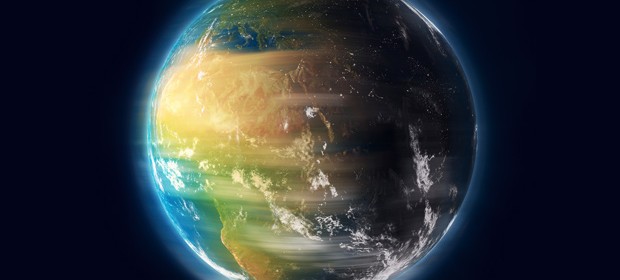We all know that the Earth isn’t stationary in space. Most, however, have no idea of just how fast or in how many ways it moves. And fewer still have taken the time to actually watch our planet move! Whenever the Moon rises at its full phase (as it will on the 16th this month), it presents an excellent opportunity to experience at least one of its motions.
The famed visionary Buckminster Fuller called our planet “Spaceship Earth.” And with good reason. It’s spinning on its axis at over 1,000 mph at the equator, moving 67,000 mph in it’s yearly orbit around our Sun, the Sun is taking the entire solar system around the Milky Way Galaxy at 550,000 mph, the Galaxy itself is moving within the Local Group and the Group in turn is orbiting the Coma-Virgo Cluster of galaxies which is taking part in the overall expansion of the universe!
Of the two of these motions we can actually see, our yearly trip or revolution around the Sun becomes evident with the slow turn of the seasons and march of the constellations associated with them. Any given star grouping isn’t rising to meet us as most assume—we are moving around our orbit and looking out into space in different directions at them. Thus it is that we see Orion in the winter and Scorpius in the summer, for example.
The other motion is much easier to see and much more dramatic to experience. It’s the Earth’s rotation—the motion that causes the Sun to rise and set each day, as well as the Moon, planets, and the stars. (Note that this nightly or “diurnal” motion across the sky is different than the slow turning of the seasons mentioned above. If that’s a bit confusing to you, don’t feel bad. It took the ancient skywatchers centuries to figure out the sky’s apparent motions!)
The best time to see this is at Full Moon, when our lovely satellite “rises” over the eastern horizon as our Daytime Star “sets” over the western one. Note that it is the horizon that is dropping down to meet the Moon—not the Moon itself rising up over the horizon! (The same is true watching the Sun rise in the morning but a lot more difficult to visualize happening due to its intense glare.) This motion is, of course, very obvious with the unaided eye alone but try it with your binoculars too. In either case, as you watch the Moon come up, think to yourself: “The ground I’m standing on is spinning at supersonic speed toward the east.” If your thought processes are intense enough—if the eye-brain combination makes the connection—you can actually feel this motion! One devoted skywatcher climbed a tall tree to get himself off the ground as he watched the Moon “heave itself” over the horizon. He swears that he became giddy, so strong was the sensation of the Earth moving!
— James Mullaney
Former assistant editor at Sky & Telescope magazine & author of nine books on stargazing. His latest, Celebrating the Universe!, is available from HayHouse.com.


